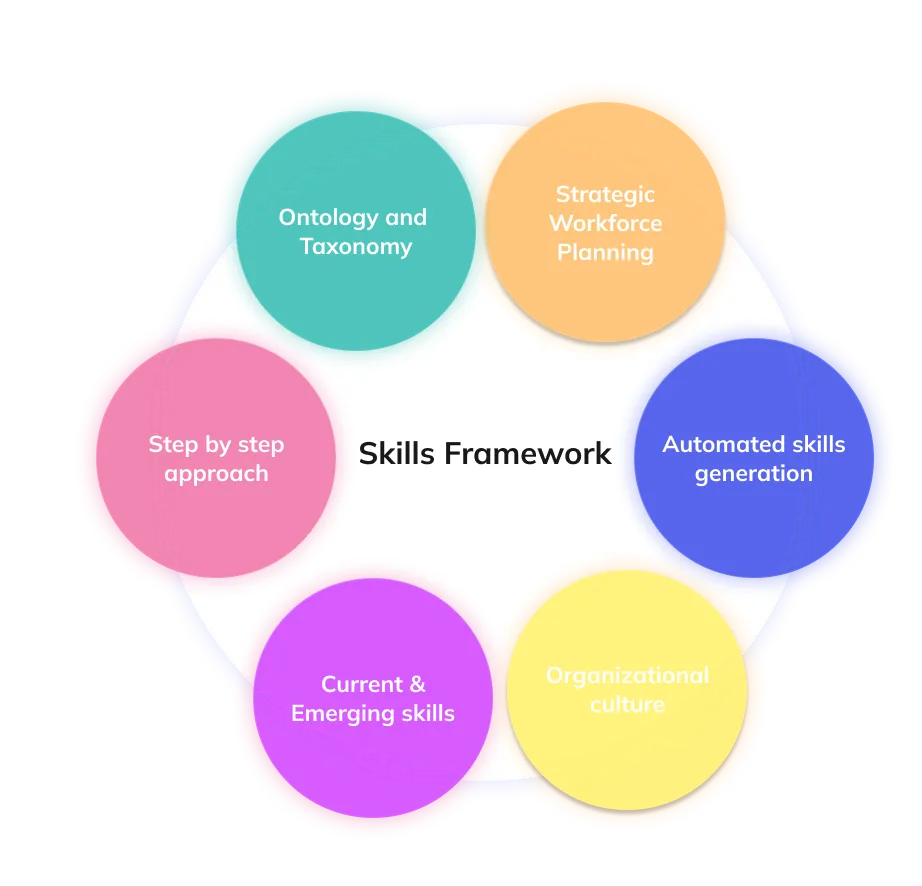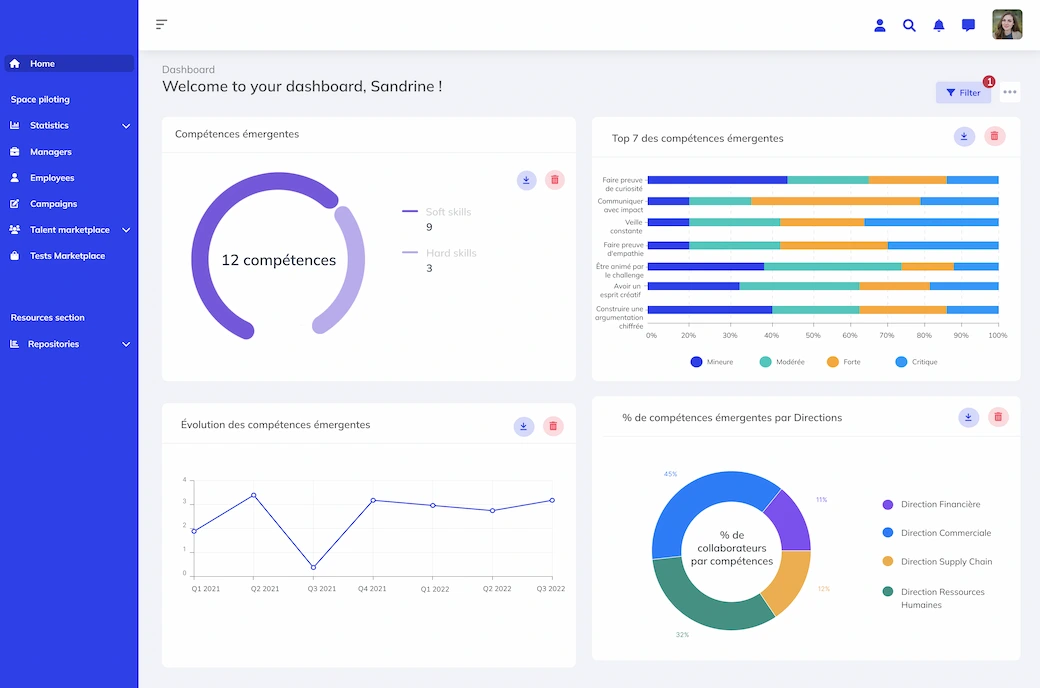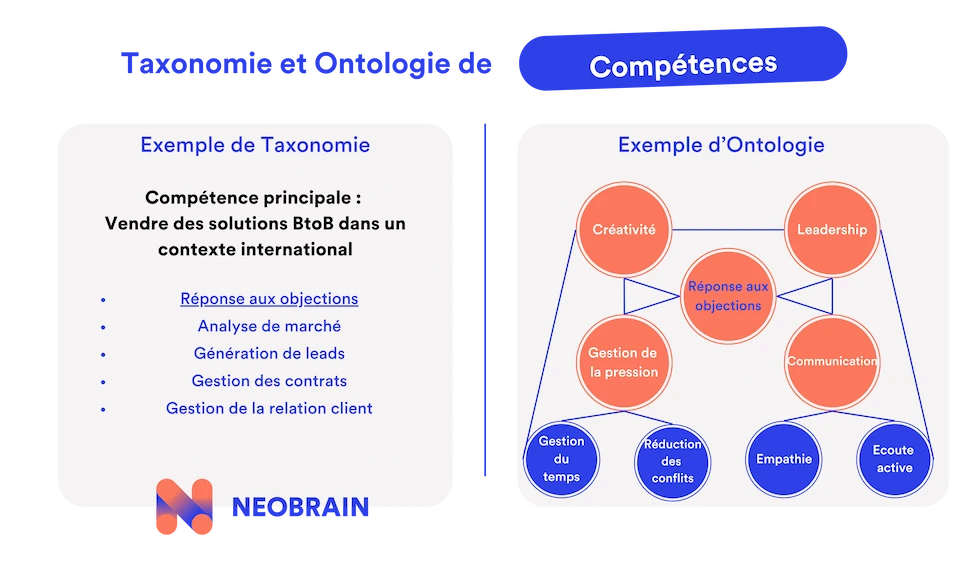Skills Framework: the essentials

- Job architecture and skills framework
- What are the current obstacles to the creation of a skills framework?
- Why use a tool that gathers a company's professional skills?
- How do you create a step-by-step skills framework?
- How to incorporate the competency framework into your approach Strategic Workforce Planning?
- Involving managers in your skills' monitoring system
- You may also like
To start with, let’s talk about the reality in companies: 58% of them have a centralized repository, but only 16% declare that it’ s up to date. This can be explained by the perception of a tedious project whose benefits do not, at first sight, seem sufficient to require such a time sacrifice!
Make no mistake, on the one hand, this tool can be created much more quickly, and on the other, as soon as you reach the critical size of 250-300 people it becomes indispensable. Here’s what Marine de Scorbiac, VP Talent, Culture and Learning at Aircall, had to say.
Marine has therefore created 3 reference systems, “universal competencies”, “technical competencies” and “leadership competencies”, in order to..:
- Rationalize and objectify career development and mobility.
- A more pragmatic approach to recruitment, which is now based on candidates’ skills .
Let’s continue by defining the terminologies used in the creation of the reference systems.
Job architecture and skills framework
How do you define a robust competency framework?
The job repository lists all of a company’s jobs in a way that is shared by all employees. Depending on the level of granularity required , this nomenclature can detail, from the finest to the broadest, the position, the job, the benchmark job and finally the job.
It enables everyone to find the key information they need to carry out their job, such as descriptions of roles and missions, methodologies, tools used, processes and best practices. The business inventory provides a common vision and facilitates mastery of their role and their world, by providing a common language and resources. This system is always created before the tool below, which details skills.
What do we call “skills framework”?
A skills repository is a tool for grouping, structuring and managing a company’s professional skills. In particular, it is used to identify the skills required for a position, as well as the levels of mastery needed for the various skills and individual and collective employee development programs.
This library can be organized into different categories, such as skills technical, behavioral, cognitive or sector-specific. The different types of skills are detailed on our page for this purpose.
What are the current obstacles to the creation of a skills framework?
Let’s be clear: if this tool hasn’t become more widespread, it’s because there are many reasons not to take the plunge. Here are the main obstacles that our customers have identified:
- Lack of Clarity : “Without a clear understanding of what the organization needs, it can be difficult to define the competencies required for success in various roles.“.
- Limited input: “If the process of developing a competency framework is done in isolation, without input from key stakeholders, the resulting framework may not be representative of the organization’s needs.”.
- Resistance to change: “Some employees may be resistant to the introduction of a competency framework, viewing it as a threat to their current status quo or as an unnecessary additional workload.”
- Skill measurement: “Measuring the skills and competencies of employees can be difficult, as it requires ongoing evaluation and assessment.”
- Maintenance and updating: “Once a competency framework has been created, it requires ongoing maintenance and updating to remain effective and relevant over time. Failure to keep it current can lead to outdated or irrelevant competency models.”
All these obstacles legitimize a form of inertia. For the sake of completeness, here are the benefits experienced by companies that have initiated this approach:
- Natixis. In less than 1 year, the French company has increased internal mobility by 60% using the repository. A winning bet in a context of talent shortage, all the more so as the cost of external recruitment averages €20K, and its failure… 50K€. See the full success story.
- Sage. As part of the transformation of its software business from On-Premise to Software as a Service, the French structure managed to develop 250 people initially, before expanding to a larger scope. Read the case study.
We’re going to show you the best practices to follow in order to unite all the parties involved and guarantee the long-term use of this system at the heart of a complete cartography.
Why use a tool that gathers a company’s professional skills?
The creation of this tool goes hand in hand with the achievement of several objectives for HR players: employees, managers and HR teams (HRD, job managers, career management managers, training managers, etc.) and social partners.
The core purpose of an employee skills model:
By describing the company’s business environment, this tool provides a benchmark for talent to take greater responsibility for managing key skills.
- A better understanding of strengths and areas for improvement. Levels of mastery of expectations provide a clearer picture of employees’ job prospects. In this way, employees can become active players in their own development.
- Continuous updating of mastery levels. To assess the levels achieved, the employee undergoes an initial self-assessment. This can then be supplemented by the assessment of managers and colleagues, giving the employee a third-party opinion.
- An opportunity to take ownership of internal opportunities. Thanks to the company’s job directory, employees can visualize the unique career paths and job gateways they can follow.
The advantages of a dynamic competency framework for managers:
- A performance management lever: an employee’s performance stems from a number of sources, including the right match between an individual’s level of qualifications and the job in hand. This internal index helps to explain and manage individual and collective performance.
- Individual adaptation of objectives : the manager now focuses on rational performance factors and encourages the targeted development of individual expertise. Objectives are now tailored to each individual, resulting in more individualized relations with each team member.
- A lever for internal recruitment: all the assets sought during a recruitment process are visible in an “Internal Talent Marketplace”. Designed as a catalog of skills that can be mobilized for projects or permanent jobs, this platform provides an opportunity to streamline resource allocation. In addition to the level of aptitude, the manager can also visualize the employee’s level of appetence for developing the know-how involved in internal recruitment.
The benefits of a skills grid for the HR team:
- A pillar of Job and Career Management: the skills base is used to estimate what the company needs to maintain its performance. In this way, it responds to the “description of the economic environment” and the impact on the company’s business of the Jobs & Skills Management which our partner Implid describes in his article“the lever for sustainable performance“. The resulting matrix provides a precise diagnosis of skills mastered and those at risk, by profession, population, seniority, etc.
- A source of rationalization for training programs : for a long time subject only to managerial injunctions, support needs now benefit from reliable indicators. Areas for upskilling and reskilling are more clearly identified, and are then discussed at career committee meetings to establish priorities. Mapping skills and rationalizing training are intimately linked.
- A first step towards Tactical workforce planning: short- or medium-term resource planning involves integrating business scenarios and planning resources not only in quantitative terms, but above all in qualitative terms.
How can we define job grading scales in a framework ?
Upstream of the skill library, the job index must be defined. A certain degree of freedom can be used in the level of association between qualifications and the individuals who use them, but it is important to agree on the definition of the index.
Here’s how not to confuse the concepts of “position” and “job”:
- The position: it refers to an individual and therefore defines a work situation specific to a single person. This position is visible on the pay slip, there are as many positions as there are employees in a company.
- The Job: It is defined by a set of positions similar by their common purposes and activities. Consequently, a job groups together positions that require similar skills .
- The business line: unlike the job, the business line cuts across several internal organizations or business units. Technical mastery and similar purposes make it possible to group together benchmark jobs into a single profession.
What skills should be integrated into your tool?
We recommend that you include 4 areas of skills in your inventory:
- Know-how at risk. Find out more about Risk of loss of skills
- Future skills. Our Facing uncertainty use case deals with this topic.
- Cross-disciplinary knowledge. They are the source of mobility: skills cross-disciplinary knowledge and mobility
- Development needs. How to detect them? Our article Identifying development needs on skills provides the answer.
How do you create a step-by-step skills framework?
Structuring the creation process
Setting up such a system is a structured process that follows 3 key stages:
- Step 1: First of all, it’s important to define the skills key skills for each position. We recommend selecting between 8 and 15 skills. This can be done using various approaches, such as job and task analysis, or by consulting employees and managers.
- Step 2: The next step is to formulate each item in detail. Our recommended wording is: “I am able to + Verb + Context + Object“.
For example, “I am able to present a business report in English at a general meeting”.
- Step 3: Finally, it’s crucial to specify the expected levels of mastery. We recommend 4 levels of mastery:
- Beginner
- Good notions but no autonomy
- Complete autonomy
- The collaborator is able to train on this concept
Once knowledge has been identified and described, it‘s time to integrate it into a management platform. This system centralizes all the company’s skills professional skills in a single system, whose added value is easy updating. We describe this in our Page on new methods for updating repositories.
It is also possible to create a matrix from an existing model or architecture called an“ontology” from skills.
What is the definition of the “ontology of skills”?
A skills ontology is a data structure that represents the skills and knowledge required for a specific set of tasks or activities. All this data from skills is linked to each other according to their proximity.
Ultimately, an ontology serves as the basis for creating a common nomenclature for carrying out various HR operations. For example, it can be used to link an employee profile to an internal vacancy, or to link a training course to an employee’s training path. Save time in creating the repository, enhance data robustness: read our complete Guide to the skills ontology.
Depending on the scope of your project, we also recommend the use of a skills taxonomy.
What is the definition of “the taxonomy of skills”?
To make this easier to understand, taxonomy is a bit like a bookshelf. You know when you arrange your books in order of difficulty or by theme? It’s the same for skills ! The HR team classifies the various items by level of difficulty or by area of skill.
Example: imagine you’re building a skills framework for a computer developer position.
Here’s how no tips for breaking down tasks:
- Evaluate the appropriateness of using various existing ontologies, while ensuring their suitability for your specific organizational needs.
- Present the skills data included in this ontology to your stakeholders in a“skills workshop“, so as to validate and refine it.
- Give users access to your tool as early as possible in the process, so that they can confirm or invalidate skills or add to it.
- Finalize your repository after further workshops.
4 best practices for structuring your sales system skills
Many of our customers have to rebuild their BOM because its design has not been optimized. Here are 4 best practices to follow:
- Build your central tool with the right people. While the involvement of business sponsors, business experts and managers helps to get the greatest possible number of people on board, it is counter-productive to ask for the participation of other functions.
- Opt for a hybrid approach. Structure the assets of the employees with the project committee composed of HR, business experts, Business Unit managers, and bring up the data on the skills needed to do the job from the employees themselves.
- Describe each skill in a consistent manner. We recommend using an action verb, a context and an object to standardize the approach and to create bridges between several businesses in the organization.
- Anticipating emerging expertise. To combat the obsolescence of certain skills and professions, you need to keep an eye on the evolution of expertise in your sector.
Artificial intelligence and sustainable development are the most significant factors influencing today’s businesses and skills. Neobrain has modeled the impact of AI on 100 businesses, and we invite you to examine these changes and draw the consequences for your skills architecture.
How to incorporate the competency framework into your approach Strategic Workforce Planning?
To create a relevant system, it’s important to take into account the specific characteristics of the company and its businesses. For example, a skills framework for a service company will be different from that of an industrial company. The Strategic Workforce Planning or Jobs & Skills Management aims to anticipate external transformations in order to maintain your employees’ employability. Also, automation, sustainable development and AI are today having a strong impact on your talents and on the emergence of new skills.
At HR team level, Neobrain provides an HR dash board designed to monitor emerging skills . In particular, this can be used as part of your training approach.

How do you adapt your instrument to your industry stakes?
To save time in developing your instrument, we recommend using the many external resources:
- The Répertoire Opérationnel des Métiers et des Emplois(ROME): the Répertoire Opérationnel des Métiers et des Emplois (ROME), built by Pôle Emploi, is a valuable source of information: based on the jobs existing within your company, you’ll find job descriptions and associated qualifications. A new version of this tool has been developed, ROME 4.0. This will save you invaluable time in building your central tool.
- Bureau of Labor Statistics (BLS): The BLS offers extensive data on employment, labor market, pay, and much more. Their Occupational Outlook Handbook is particularly useful, providing detailed information on various professions, including required skills and future job market trends.
- LinkedIn Industry Insights: LinkedIn, being a major professional networking site, offers insights into job trends, in-demand skills, and detailed information on various roles and industries.
- Industry-Specific Professional Associations: Many industries have their own associations that publish job and skills data. Examples include the American Medical Association (AMA) for healthcare or the National Society of Professional Engineers (NSPE) for engineering.
- U.S. Department of Education’s Career and Technical Education (CTE) resources: These provide insights into various career paths and the skills needed in different sectors.
Involving managers in your skills’ monitoring system
Implementing your tool requires the support of all company players, especially managers. They must be trained in the use of the deployed system, after having been made aware of its benefits for their team. We recommend including them in the identification of the skills required for each position, and in the implementation of an action plan to develop their teams.
The key success criterion of the system is the use of the catalog at various key moments:
- Employee performance appraisal.
- Constitution of the succession plan.
- Objectification of mobility or evolution.
- Planning of the support path
That’s why ergonomics and ease of adoption are key determinants in the choice of your final tool. The user experience counts enormously, and enables the HR team to“score points” with a population of managers renowned for their ability to challenge HR initiatives. Here are a few keys to a successful transition.
In conclusion, the introduction of a skills professional repository is an essential step in a rapidly changing competitive environment. It is only the beginning of a governance process that is vital to the long-term future of the system.
Neobrain can help you solve your system’s design and day-to-day management problems:
- Put an end to endless workshops to formalize the content of your architecture.
- Go beyond a static model that doesn’t feed on new expertise in your environment.
- Remove duplicate skills that compromise the exploitation of the data
- Create a model that will actually be used and promoted by the trades.
FAQ
- How long does it take to list all the skills needed?Depending on the complexity of the loom, we recommend between 8 and 15 attributes per loom. In the workshop, you’ll need 2 hours per craft.
Using an AI-based solution will enable you to generate skills from your industry’s data, saving you an average of 40% time. You can then customize them to your specific needs.
- How to choose the skills to be included in your framework?Out of 15 skills we recommend 8 hard skills, 4 soft skills and 3 transversal skills for a technical job skills .
The choice of skills is made with the business experts, B.U. Directors, HR. We advise anticipating emerging skills to integrate them into the collection.
- How to measure the effectiveness of a skills framework?In the first instance it is important to check its consistency:
- Do all employees have an assigned manager?
- Are all employees attached to a job?
Then, its effectiveness is measured in the use of the tool during performance reviews and training plans. Ultimately, the objective is to see skills improve.
- How to avoid duplication of skillsDuplications of skills can reach up to 15-20% of the frames of reference. The first step is to formulate qualifications in a consistent way, i.e.: “I am capable of + verb + context + complement”.
Moreover, artificial intelligence will come to your rescue to identify and deduplicate them thanks to its semantic analysis.
- How to update the skills' repository?Updating is the key to long-term repository use. We recommend 3 activities:
- Establish a governance team that reviews the repository on a regular basis.
- Benefit from emerging expertise suggestions provided by an AI.
- Allow employees to add to their profile according to your own rules.
Do you still have questions ?
Please feel free to contact us for more information 😃














